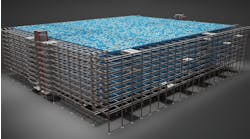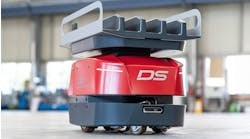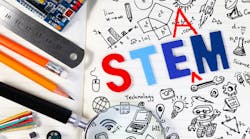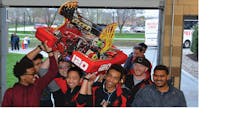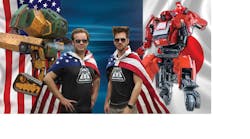STEM Saves the World: How the Avengers Made the Heroes Manufacturing Needs
At the end of the month, the greatest number of superheroes will assemble in Avengers: Infinity War to defend the world from a threat they cannot tackle alone, a threat that’s been building and teased in the Marvel Cinematic Universe since 2012. Expect some of the aging heroes to leave for good, while a new generation takes their place.
In a less overt way, this is what’s facing the American manufacturing industry with the skills gap, the deficit of trained workers to fill advanced roles. One of the key antagonists here, the Silver Tsunami, sounds like a galactic villain, but actually refers to retiring Baby Boomers. The last will reach 65 by 2029 and Deloitte reports manufacturing could be 2 million jobs short in 2025. Besides often being plants' most knowledgeable workers, boomers also own 2.34 million businesses and employ 1/6 of U.S workers, according to the non-profit Project Equity.
The situation is dire, and we need fresh talent with brand new powers to fight new employment battles, from automation to globalization. The greatest threat may be from within, though.
There's been a prolonged national apathy towards science, technology, engineering and math, collectively known as STEM. A 2015 Pew survey of American Association for the Advancement of Science found 46% of its scientists thought STEM education for grades K-12 was below average.
More troubling, 52% of teenagers surveyed say they have no interest in manufacturing, according to the Economics Public Institute. That’s kind of crazy when minimum wage is $7.25 and some manufacturing jobs (requiring no degree) start at $25. You also get to work with cool tech in a stimulating environment. Should be an easy sell, but more than half of teenagers aren’t even interested.
Instead of repeating the platitude that teens think manufacturing is dirty, dangerous and whatnot, let’s think about the interests of this generation that will need to replace your most experienced people. One PG-rated answer: Marvel movies such as Infinity War. Domestic box office, a clear indicator of popularity, show that Marvel Studios movies specifically have grossed nearly $6 billion since Iron Man came out in 2008.
Marvel’s Black Panther, released two months ago, became the third-highest-grossing movie of all time in North America. That’s cultural-phenomenon level, tapping into the current zeitgeist around racial and economic disparity, with the plot revolving around whether those with great power—in this case technological power—have a great responsibility to help.
That movie ends with the African technotopia of Wakanda developing a science-based outreach center in Oakland, Calif., to be run by the hero’s genius teen sister, and kingdom’s lead engineer, Shuri, who has achieved Madame Curie levels of admiration from fans, and she’s not even real.
A few weeks after the movie opened, Marvel’s parent company Disney capitalized on the popularity by announcing it would donate $1 million to the Boy and Girls Club of America to grow youth STEM programs by building STEM centers of Innovation in Oakland and 11 other metropolitan areas.
"It is thrilling to see how inspired young audiences were by the spectacular technology in the film," says Disney CEO Bob Iger. "So it's fitting that we show our appreciation by helping advance STEM programs for youth, especially in underserved areas of the country, to give them the knowledge and tools to build the future they want."
Why You Should Care
Avengers: Infinity War is tracking to have the biggest opening of all time. For this young generation, it could be the cinematic equivalent of the moon landing. And here, the key component driving most of the heroes is a solid foundation in STEM, from the powered Iron Man exoskeleton of Tony Stark to the gamma radiation accident that turns Bruce Banner into the Hulk when he’s angry. So even if teens are apathetic to manufacturing, they are fascinated in some way with the fields that make it possible, paying a good amount of money to see science and technology used in fantastic ways.
Of course, a large part has to do with good-looking, charismatic actors, but there has to be something more to it. Nobody has a better sense of who these characters are right now then the directors of Infinity War, Anthony and Joe Russo, who I recently spoke with about these characters and their connection to STEM.
“Their fluency in science and technology is a big part of their super power, if not their entire super power in some cases,” Anthony says. “That’s a core part of their identity and who they are.”
And kids love who they are, dressing as them and pretending to live out their adventures. I wasn’t around in 1969, but I’m guessing a good amount of manufacturing workers 55 and up had the same connection with astronauts. The science in these movies is of the fictional variety, but its impact should not be disregarded.
“These movies are driven by imagination; science is also driven by imagination,” Joe adds. “What can we accomplish? It’s about ambition and desire to better the world through technology. Both Shuri and Tony Stark are characters who represent that. Movies and stories have a very specific place in our lives. They do inspire us. And I do think there is real potential for these types of films to incite the imagination of future inventors.”
While the story is mostly imagination, the production team consulted top-level scientists and engineers to vet the science in their story and ensure how the characters approached certain situations was plausible.
“How do we base ourselves in what is real today and figure out how to go one step beyond that in our fantasy stories we’re telling?” Anthony asks.
The people who can take us one step further are alive right now, in classrooms with the latest computers, robots and 3D printers, and also in ones with tattered outdated text books and PCs so old they have Oregon Trail on them. Every kid in America might not have the same access, but where you were born or how much money your family has doesn't diminish your potential.
Anyone can be successful in manufacturing if they want to put in the work and learn. Maybe losing sight of that is why there's the ominous threat of a skills gap looming over the industry.
Fifteen million, children, or one in five, live below the poverty line in America. Let's assume that the majority have less technological opportunities than those above this threshold. Wouldn't it be most sensible, if you have a lack of workers, to focus on those who could benefit the most from high paying jobs with often minimal introductory education?
Now, if only we can harness that interest in these movies and characters into real-world interest in science and technology. Marvel, nicknamed the “House of Ideas,” and Disney are great muses for the world of tomorrow, but it’s industry’s role to do the hard work
“It’s our job to support the next generation of innovators from all walks of life to help move humanity forward in the most positive way possible,” says Joe.
Where to Start
If you’re in a leadership role in manufacturing, all this should come as welcome news. Yes, there’s tumultuous times coming, but the heroes you need are out there and want to help. You just need to assemble them.
Possibly the easiest way to immediately get involved is to get involved with FIRST Robotics. Founded by inventor Dean Kamen in 1989, the international robotics organization for students in up to high school has more than 400,000 members and 90,000 mentors and immediately provides the skills manufacturers need.
“These students are learning all kinds of mechanical engineering skills: machining, welding, soldering, how to assemble gear boxes, pneumatic systems, how to wire electrical boards, assemble motor vectors and unit switches,” explains Marie Hopper, president of FIRST North Carolina.
Hopper has been a volunteer since 2001, and has worked with companies such as Bosch Rexroth who mentor clubs and bring the students into their facilities to get an idea of the jobs they can have someday, from engineering to the C-Suite.
“In addition to those hard skills, they’re learning what I think is even more critical skills,” Hopper says. “They are learning how to problem-solve, how to make a mistake and recover from it, and come up with solutions.”
The huge FIRST Robotics Competition Championsip, which starts this year on April 18 in Houston, is the culmination of months of learning how to make a business plan, market their robot, and ensure the project has immaculate accounting and is under budget.
Excluding the original robot kit of parts, motors, wheels and gear boxes, a team, usually around 35 kids, cannot add more than $4,000 to their project. And if this is a donated part, like a titanium plate, someone must figure out how much it would cost for the bill of materials.
This experience must work, as FIRST reports more than 75% of alumni go into a STEM field as a student or professional, based on a study by Brandeis University.
“It’s a path to a nice prosperous job,” Hopper says. “Even if they don’t go into engineering, they can think like an engineer and get almost any job they want to get, because they have the ability to think logically and make decisions.”
This is an area many large manufacturers have decided to invest efforts in the non-profit clubs, with dozens sponsoring more than 20 teams, from Boeing to John Deere. Disney is also on that list.
Not every town can support full-fledged STEM innovation center, but even small towns have a machine shop or small manufacturer who can at least offer technical advice. And the payoff extends far beyond the skills gap. You can find a team in your area to sponsor HERE.
“In the rural and low income areas, we’re giving kids a step out of poverty,” Hopper says. “A lot of non-profits offer food, shelter and clothing. Our goal is to prevent the need for these services.”
Real Results
It’s one thing to hear from adults on how STEM programs can train and mold students into a capable fighting force for the benefit of themselves, their communities and industrial employers. But it’s another to meet one of these future manufacturing heroes.
I had that pleasure last year at the IndustryWeek Manufacturing & Technology Conference & Expo in Cleveland when I spoke to Peng Zhou, who at 17 had achieved more than most of us will in our lives.
He came to America from China at age 4, and in high school was introduced to STEM through Cuyahoga Community College’s Youth Technology Academy in Cleveland. Starting with VEX robots, modern motorized Tinker Toys, Zhou moved onto the bigger FIRST Robotics team, helping the Red Dragons overcome 900 other teams from 42 nations to win the 2016 FIRST Robotics Competition in St. Louis.
Not stopping there, Zhou also built a computer out of Raspberry Pi’s to detect cancer and search for black holes— and possibly alien armies. His accomplishments earned him an invite in October 2016 to meet President Barack Obama, science advisor John Holdren, NSF director France Cordova, NASA director Charles Bolden and astronaut twins Scott and Mark Kelly. It was part of the former president’s Kid Science Advisor initiative to emphasize STEM fields.
But he says without the encouragement, he would be just a mild-mannered student.
“If it wasn’t for TRI-C’s Youth Technology Academy, I wouldn’t be where I am now,” says Zhou, now 18 and an engineering student Cleveland State University, as well as an intern for Rockwell Automation working on PLCs.
Instructors gave him the workplace, the parts and the mentoring to make the robots and DIY computer.
He says outreach from community colleges and employers into lower income areas is just common sense: “Not all the smart kids are from the suburbs.”
He says the seeds were planted long ago in 2008, when he saw the first Iron Man.
“Iron Man was one of my favorites because he built his own suit,” says Zhou, who may be more like Spiderman’s alter ego, Peter Parker, because he’s a teen who hangs around labs so much.
“It’s like a home,” Zhou says of the campus lab.
He’s also weaving an equally heroic goal: “Something I want to invent is robotic prosthetic parts. With the skills I’ve learned, I’m getting closer and closer to that point.”
As we know from our comic lore, great people can come from anywhere, be any color and any religion. Zhou is just one person who is clearly naturally gifted, but needed a push. Our world is not under threat of a giant omnipotent alien like Thanos in Infinity War, but it’s messed up and needs people to believe it can be saved.
With such an emphasis on the greater good and how technology can facilitate that, the next generation is on the precipice of the skills gap, ready for their push. But this moment won’t last forever.
“If you don’t get kids into STEM fields early, you’ve probably lost their interest,” Zhou says.







